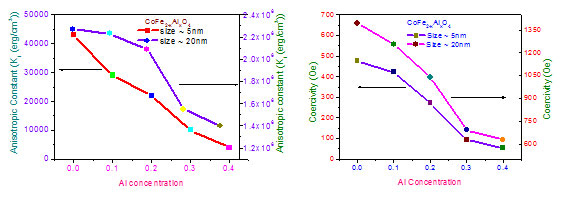Recently Low magnetic anisotropic constant nanomaterials for soft magnetic applications and nano-polymer composites have been demonstrated at IIT Patna.

The cubic CoFe2O4 has large magneto crystalline anisotropy energy with positive anisotropy constant. It has a six easy directions along the cube edges of the crystal represented as , four hard directions across the body diagonals denoted as and twelve saddle points across the face diagonals which lead to positive magneto crystalline anisotropy constant. The large magneto crystalline anisotropy energy of cobalt ferrite is mainly attributed to the Co2+ ions on the B sites of the spinel. As the crystal field is not capable to quench the orbital magnetic moment, there is strong spin –orbit coupling (L-S coupling) and due to this coupling there is large magneto crystalline anisotropy energy (MAE). Thus large multiaxial positive magneto crystalline anisotropy constant makes it hard magnetic material. This magneto crystalline anisotropy is a very important parameter in connection with the characterisation of the materials utilised in technological applications, particularly magnetic recording media and, it can be tuned by replacing A site and/or B site by different transition elements. Magneto crystalline anisotropic constant depends on size of the particle and crystal structure parameters such as, lattice parameter, bond lengths, bond angles etc.
Here, we have demonstrated that, The magneto crystalline anisotropic constant is highly size dependent. Hence, The anisotropic constant increases with the annealing temperature i.e. increasing crystallite size. As the crystallite size increases the volume to surface ratio increases. The volume contribution to the anisotropic constant is more compared to surface and, hence the anisotropic constant increases with the increase of size of the nanocrystalline material.
The variation of cubic anisotropy constant with the Al3+ concentration of the samples shows that anisotropy constant decreases with the Al3+ concentration. The strong anisotropy of pure cobalt ferrite (CoFe2O4) is primarily due to the presence of Co2+ ions on the octahedral sites of the spinel structure. The crystal field (trigonal field) is not capable of removing the orbital degeneracy of Co2+ at the octahedral sites so that the orbital magnetic moment is not quenched and therefore there is a strong spin- orbit coupling which produces large magneto crystalline anisotropy energy. With increasing Al content may reduce the cobalt ions from the octahedral sites. Therefore it reduces the spin orbit coupling which leads to decrease in anisotropy constant. The anisotropy field is an indirect measurement of the crystal anisotropy forces which bind the magnetization to a preferred direction. For a cubic crystal with easy
direction along the [100] direction, the anisotropy field Hk can be calculated using the formula, . It is observed that the anisotropy field decreases with increasing Al3+ concentration which leads to decrease in coercivity. Substituting Aluminium in cobalt ferrites reduces saturation magnetization, coercivity, remanent magnetization and magneto crystalline anisotropy constant which reveal that the materials become soft magnetic material with the Al3+ subs. It can be a potential candidate for soft magnet applications such as magnetic recording.
. It is observed that the anisotropy field decreases with increasing Al3+ concentration which leads to decrease in coercivity. Substituting Aluminium in cobalt ferrites reduces saturation magnetization, coercivity, remanent magnetization and magneto crystalline anisotropy constant which reveal that the materials become soft magnetic material with the Al3+ subs. It can be a potential candidate for soft magnet applications such as magnetic recording.
This research is published in these articles:
- Influence of Al3+ concentration on the crystal structure and magnetic anisotropy of nanocrystalline spinel cobalt ferrite, Lawrence Kumar and Manoranjan Kar, Journal of Magnetism and Magnetic Materials 323 (2011) 2042–2048.
- Effect of Annealing Temperature and Preparation Condition on Magnetic Anisotropy in Nanocrystalline Cobalt Ferrite, Lawrence Kumar and Manoranjan Kar, IEEE TRANSACTIONS ON MAGNETICS, VOL. 47, NO. 10, Page 1-4, OCTOBER 2011.




